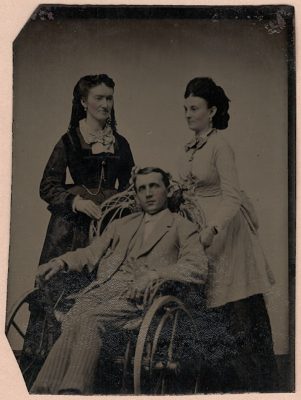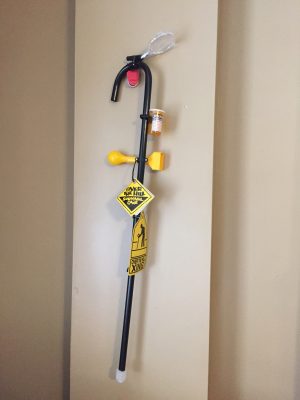Over-the-hill canes and ideal bodies: teaching disability history as public history
07 February 2018 – Nicole Belolan
Editor’s note: The post is the sixth in a series commissioned by The Public Historian that focuses on essays published in TPH that have been used effectively in the classroom. We welcome comments and further suggestions! If you have a TPH article that is a favorite in your classroom, please let us know. You can send your suggestions to [email protected].

Tintype of unidentified group. From collection of Nicole Belolan
As I crafted my syllabus for an undergraduate introduction to public history course last summer in anticipation of teaching that course at Rowan University, I knew I wanted to incorporate my own specialty of disability history. The disability history field is still fairly new, so it is a joy to teach in any history course because so few students have been introduced to it before. Since I was teaching a course in public history, it only made sense to talk also about how to make history and the humanities, broadly defined, as accessible and inclusive as possible at museums and historic sites. Including the topics of disability history and inclusion in museums in my course certainly spoke to my strengths and, let’s be honest, made those sessions a little easier to prepare for than others! But it also spoke to my professional interest in serving diverse audiences in museums and other settings where the public encounters history. These are topics about which I have learned a lot over the past few years (and have much more to learn) as a museum professional and historian of the material culture of disability, including through some of the great resources provided by publications such as The Public Historian.
To teach this unit, I knew I would assign Katherine Ott’s “Disability and the Practice of Public History: An Introduction” (The Public Historian 27, no. 2 (2005): 9–24). This was one of the first articles about museums and disability I read several years ago. Even though the article is now over ten years old, I think it remains relevant and good to teach with. Ott provides an overview of the representation of the human body in museum exhibitions from freak shows to the display of wet specimens of body parts in medical museums. She provides examples of the many ways we tend to emphasize what she calls “some idealized body” (21) (as opposed to “diversity” in bodies or people) in museums. She cites healthy, robust-looking Native Americans featured in a 1981 diorama at the Smithsonian’s National Museum of Natural History as one example of idealized bodies in museums and contrasts them with the more recent and comparatively realistic representation of a former president at a National Park Service site: a statue of Franklin Delano Roosevelt seated in a wheelchair at the Franklin Delano Roosevelt Memorial in Washington, DC.
In class, we read and talked a lot about what constituted “ideal.” In one exercise, we talked about this “over the hill survival cane” I bought at a party store. It was designed to be a joke about changes in the body we stereotypically associate with old age. As a group, we teased out the ways the cane represents the ideal way to age today.

“Over the hill survival cane” Photo credit: Nicole Belolan
For instance, at the top of the cane, there is a set of chattering dentures, which suggested to my students that we prefer to age with our own teeth. A few inches farther down the cane, there is a fake pill bottle labeled “OVERTHEHILL CURE-ALL PILLS” for ailments such as “ OLD FOGY FIBER PILLS,” “WRINKLE-ERASER GELS,” and “HOT FLASH PILLS,” which suggested to students that we are ashamed of certain aspects of aging and that there should be medical fixes for them. The cane also suggests that debility and disability always accompany old age and that we do not want to be seen using a cane or walker. The interpretations are endless. Using this cane as a talking point, the students quickly gleaned the complexity behind interpreting and consuming the history of disability in public history settings. So we asked, how can we promote the inclusion of more ordinary individuals—like older people or anyone who might use a cane—in history and make that history accessible to as many prospective visitors as possible without necessarily poking fun at ourselves or disability, broadly defined? I did not expect my students to develop concrete answers to this question, but I wanted to get them thinking about it.
To see how some public historians have answered this question, we also read the case statement in “Making Public History Accessible: Exploring Best Practices for Disability Access—2016 Working Group” on the NCPH website, as well as Katherine Kudlick’s 2016 essay, “Subversive Access: Disability Goes Public in the United States” and Franklin D. Vagnone and Deborah E. Ryan’s “Experience Markings,” in The Anarchist’s Guide to Historic House Museums (2016).
Ott’s article provided a good overview. The “Making Public History Accessible” working group outlined several recent, concrete examples of how professionals in the field make history accessible. Kudlick’s blog post provided a short and to-the-point explanation of how museum professionals can make exhibitions accessible, using “Patient No More: People with Disabilities Securing Civil Rights” at the Paul K. Longmore Institute on Disability at San Francisco State University as a case study. Finally, The Anarchist’s Guide emphasized the importance of interpreting history in museum settings in a way that incorporates all the senses and encourages access to as much of a museum as possible. Freeman Tilden mused on similar themes in his classic Interpreting Our Heritage (1957) (which my students also read), but Vagnone and Ryan rehashed these themes for a new audience.
I also introduced disability history to my students using historic artifacts—mostly nineteenth-century and early twentieth-century photographs depicting ordinary people with physical disabilities—from my collection. I am never disappointed in the discussion when I show these images to groups. One late nineteenth-century tintype, which features a well-dressed group of people, including a man sitting in a wheelchair, got students asking questions about what the wheelchair was made of, how much it may have cost, and where the money to acquire it might have come from. When students looked at these images, they were surprised by the fact that people with disabilities were in historic photographs at all. But they pointed out that Ott’s article explains perhaps one reason why the images elicited surprise: “Public historians tend to overlook content about . . . people with disabilities because visitors [or in this case, my students] no more expect to see them in exhibits than they do in their everyday lives.” I hope this is changing as public historians such as Ott produce exhibitions that integrate and showcase stories of people with disabilities. For one example, check out the National Museum of American History’s online exhibition EveryBody for more material culture and disability history.
Class discussions and readings prepared students to view and critique an exhibition at the Library Company of Philadelphia for a written assignment. Students visited Common Touch: The Art of the Senses in the History of the Blind, which ran from April 2, 2016, to October 21, 2017. The exhibition featured historic artifacts used and associated with blind individuals. Working with an artist-in-residence, Library Company staff put those artifacts into what they describe on the project website as a “multisensory” (and it was!) conversation with contemporary art inspired by those objects.
Students took notes on design and layout, content, and accessibility. Then, they wrote short critiques of the exhibit in which they incorporated class readings and discussion. Through class discussion and their papers, we talked about language (what is the difference between using the phrase “person with a disability” and “disabled person”?) and what it means when the media depict people with disabilities as individuals who “overcome” their disabilities to live their lives. We also talked about the museum exhibition itself. My students all learned something about the history of the material culture of blind individuals (who knew there were so many varieties of raised print?). To my surprise, the visit also diversified their museum experience. For instance, several students commented that they thought the Library Company exhibition was small, perhaps signaling the fact that many students are accustomed to visiting large art and science museums—favorites of school teachers, at least when I was a kid—with lofted ceilings and jam-packed galleries.
I could have devoted even more class time (or perhaps an entire course) to this topic. Without a doubt, this unit included a lot of new material for students to process. But I had to make room for equally important and compelling issues in public history. At the very least, I think I introduced my students to new historical content but also to a world of practice in the field many students had not thought about or recognized until this class. Ott’s article and the other readings listed here provide great introductory material for the topic of disability history and accessibility in public history.
One of my teaching objectives is to encourage students to be advocates for preserving cultural heritage of all kinds, but I hope my students also think about making that heritage accessible to everyone. I would love to hear from you about how you teach this topic in your introductory public history or museum studies courses!
~ Nicole Belolan is program coordinator and fellow-in-residence at the Consortium for the History of Science, Technology and Medicine in Philadelphia, Pennsylvania.




Herzlichen dank für diesen schönen und wichtigen Artikel. Es zeigt sich, dass Disability History sich weiter professionalisiert und den Weg in die Öffentlichkeit sucht. Es scheint so, dass gerade die Vermittlung von Disability History in Schulen langsam an Fahrt gewinnt. Nicht nur in den USA, sondern auch in Deutschland gibt es verschiedene Initiativen dazu. Ein Beispiel gibt es hier, vielleicht ist es interessant auch für die Leser dieser Website:
https://www.public-disabilityhistory.org/2018/01/disability-history-meets-teacher.html
Thank you very much for this beautiful and important article. It turns out that disability history is further professionalizing and finding its way into the public eye. It seems that the teaching of disability history in schools is slowly gaining momentum. Not only in the US, but also in Germany, there are various initiatives. There is an example here, maybe it is interesting for the readers of this website:
https://www.public-disabilityhistory.org/2018/01/disability-history-meets-teacher.html
I manage the St Peter State Hospital Museum in St Peter, MN. We are putting together an exhibit for the Nicollet County Historical Society Treaty Site History Center on our facility. I wonder if you have any advice for telling the history of mental illness.
Hi, Beth, – Please feel free to send me an email telling me a little more about your project, and I would be happy provide you with some resources.